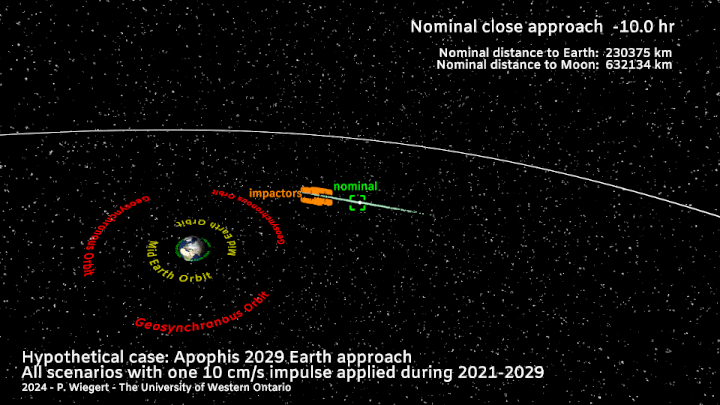The near-Earth asteroid 99942 Apophis will pass near our planet in April 2029. Extensive observations and calculations reveal that it is on track to safely miss our planet by tens of thousands of kilometers.
However, calculations of Apophis' path to date have not considered the possibility that Apophis could be struck by a small asteroid or meteoroid, like the ones that occasionally and unpredictably hit the Earth and are observed as meteors or shooting stars.

The likelihood of any asteroid being deflected in a significant way by a small asteroid impact is extremely low. It is only the unusual nature of Apophis that leads us to consider it in detail here, so that we can understand its future motion as well as possible.
This new paper accepted by the peer-reviewed Planetary Science Journal, computes the odds of Apophis being significantly deflected by such an impact to be less than 1 in a million, and only 1 in a billion that the deflection will be dangerous to Earth. An open-access version of the published paper is available here. If you are unable to access that link, a prepublication draft with the same content is on Arxiv at this link.
The analysis also discusses how and when a deflection of Apophis would become apparent to observers on Earth, and how telescopic observations can be used to assess whether or not Apophis has been deflected.
To determine the chances of Apophis being deflected onto a trajectory that would strike the Earth, thousands of hypothetical scenarios were examined where a small velocity change or "impulse" was applied to Apophis from a random direction and at a random time. The effect of this impulse on Apophis' distance to the Earth near the time of close approach to Earth in April 2029 was then examined. Sufficiently large (greater than 5 centimeters per second change in velocity "delta-vee") impulses, corresponding to the impact of a 3 meter diameter or larger asteroid impact on Apophis, were found to be able to deflect Apophis into Earth impact in 2029, but the odds of such an impact occurring are less than one in a billion, far below the risk threshold of one in a million normally adopted for asteroid impact risk assessment.
An illustration of one set of these hypothetical scenarios are illustrated in the accompanying animation, where a change in velocity of 10 centimeters per second is applied to Apophis some time during 2021-2029. Such an impulse is extremely unlikely, but could create an Earth impact in approximately 5% of the cases examined. Given the extreme rarity of sufficiently large impacts, the overall odds of a small asteroid deflecting Apophis onto a dangerous path is extremely small.
Related links
Have a question or comment? Contact me (Paul Wiegert at pwiegert[the @ sign]uwo.ca)